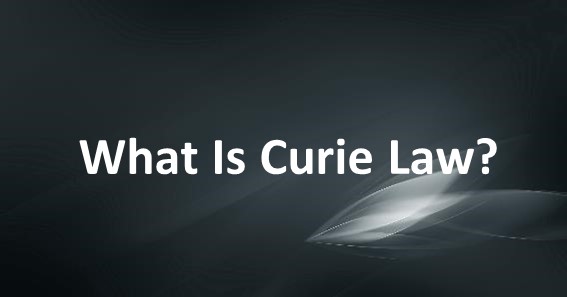Are you curious to know what is curie law? You have come to the right place as I am going to tell you everything about curie law in a very simple explanation. Without further discussion let’s begin to know what is curie law?
In the fascinating realm of physics and materials science, the Curie law stands as a fundamental principle that describes the behavior of paramagnetic materials in the presence of magnetic fields. Named after Pierre Curie, the renowned French physicist, the Curie law provides insights into the relationship between magnetization, temperature, and magnetic susceptibility. In this blog post, we will delve into the world of the Curie law, unraveling its principles, applications, and significance in understanding magnetic materials.
What Is Curie Law?
The Curie law states that the magnetic susceptibility of a paramagnetic material is inversely proportional to its absolute temperature. This principle applies to materials composed of atoms or ions with unpaired electrons, which possess intrinsic magnetic moments. Paramagnetic materials are weakly attracted to magnetic fields due to the alignment of their atomic or ionic magnetic moments with the external field.
Key Principles And Formulation:
- Magnetic Susceptibility: Magnetic susceptibility refers to the degree to which a material can be magnetized when subjected to an external magnetic field. The Curie law states that the susceptibility (χ) of a paramagnetic material is given by the equation:
χ = C / T
where C is the Curie constant, which depends on the material, and T is the absolute temperature.
- Inverse Relationship: The Curie law establishes an inverse relationship between magnetic susceptibility and temperature. As temperature increases, the magnetic susceptibility of a paramagnetic material decreases. Conversely, as temperature decreases, the susceptibility increases.
- Curie Constant: The Curie constant (C) varies for different paramagnetic materials and is influenced by the nature of the material’s atomic or ionic structure. It is determined experimentally and represents a material’s response to the application of a magnetic field.
Applications And Significance:
- Material Characterization: The Curie law provides a valuable tool for characterizing paramagnetic materials based on their temperature-dependent magnetic properties. By studying the variation of susceptibility with temperature, researchers can gain insights into the composition, structure, and behavior of magnetic materials.
- Magnetism and Phase Transitions: The Curie law is closely linked to the phenomenon of magnetic phase transitions. As a paramagnetic material approaches its Curie temperature (Tc), it undergoes a transition from a paramagnetic state to a non-magnetic state. This transition is associated with changes in the alignment of magnetic moments within the material, leading to alterations in its magnetic properties.
- Magnetic Resonance Imaging (MRI): The principles underlying the Curie law have significant implications in the field of medical imaging. Magnetic resonance imaging (MRI) relies on the behavior of paramagnetic substances in a magnetic field to generate detailed images of internal body structures. Understanding the response of paramagnetic materials to magnetic fields is crucial for the development and optimization of MRI techniques.
- Magnetic Storage and Data Encoding: The Curie law plays a role in magnetic data storage technologies such as hard disk drives. The manipulation of magnetic domains within storage media relies on the behavior of paramagnetic materials, allowing for data encoding, retrieval, and storage.
Conclusion:
The Curie law, formulated by Pierre Curie, provides a fundamental understanding of the behavior of paramagnetic materials in the presence of magnetic fields. This law highlights the inverse relationship between magnetic susceptibility and temperature, shedding light on the characteristics of magnetic materials and their response to external influences. From material characterization to applications in medical imaging and data storage, the Curie law continues to shape our understanding and utilization of paramagnetic materials, contributing to advancements in science, technology, and everyday applications.
FAQ
What Do You Mean By Curie Law?
According to Curie’s Law, the magnetization in a paramagnetic material is directly proportional to the applied magnetic field. If the object is heated, the magnetization is viewed to be inversely proportional to the temperature. The law was discovered by the French physicist, Pierre Curie.
What Is The Curie Law Of Temperature?
According to this law, the magnetization in the paramagnetic material is inversely proportional to the temperature, which means the more the temperature of the paramagnetic material increases, its magnetization decreases.
What Is The Formula For The Curie Law?
magnetic susceptibility
…approximate relationship is known as Curie’s law and the constant C as the Curie constant. A more accurate equation is obtained in many cases by modifying the above equation to χ = C/(T − θ), where θ is a constant.
What Is The Curie-Weiss Law Class 12?
The Curie-Weiss law is one of the important laws in electromagnetism that says that the magnetic susceptibility is above the Curie temperature point of a ferromagnet in the paramagnetic region. The magnetic moment is a quantity of a magnet that determines its torque in an external magnetic field.
I Have Covered All The Following Queries And Topics In The Above Article
What Is Curie Law In Magnetism
What Is Curie Law ?
What Is Curie Law?
What Is The Curie Law
What Is Curie Weiss Law
What Is Curie Law Of Paramagnetism
What Is Curie Law In Magnetism?
Curie Law Formula
State Curie Law For Paramagnetic Material
Curie’s Law Is Valid For Which Type Of Magnetism
Curie-Weiss Law
Curie Law Derivation
Curie’s Law Which Chapter
Curie Law And Curie-Weiss Law
Curie Constant
What Is Curie Law
What is Curie law and its application
What is Curie law?

